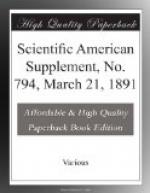* * * * *
ESTIMATING CARBON IN ORGANIC SUBSTANCES.
BY J. MESSINGER.
This is an improvement on the author’s method of two years ago. The method is now applicable to compounds with which previously low results were obtained.
The substance is weighed into a small tube 24 mm. long and 11 mm. wide, and is then introduced into the decomposition flask, which contains 6 to 8 grms. of chromic acid, care being taken that the chromic acid does not come into contact with the substance under analysis. The decomposition flask is fitted with a thistle funnel, and is connected to the reversed condenser and apparatus shown in the figure. Fifty c.c. of concentrated sulphuric acid are run into the flask. During the whole of the operation a gentle current of air (free from carbon dioxide) is passed through the apparatus. The asbestos plate underneath the flask is then warmed, and thus the flask and contents are warmed by radiant heat from the plate alone until the sulphuric acid darkens. At this point, where decomposition of the organic substance begins, the flame is entirely removed. The carbon dioxide (with some carbon monoxide) passes through the condenser and then over a heated mixture of copper oxide and lead chromate contained in a tube 15 cm. long. The gas (CO2) then passes through a U-tube, in one limb of which is sulphuric acid, in the other glacial phosphoric acid.
[Illustration: APPARATUS FOR THE ESTIMATION OF CARBON IN ORGANIC SUBSTANCES.]
Thus dried it passes through weighed potash bulbs, after which is placed for safety a small tube containing soda lime and phosphoric acid. After the lapse of about twenty minutes, warming may be once more proceeded with in the same manner as before, and after about two and one-half hours the asbestos plate may be placed directly below the flask, and more strongly heated. The whole operation is very easily carried out, and needs no watching.
With substances containing halogens, it is advisable to place, after the copper oxide tube, a small washing flask containing potassium iodide solution.
* * * * *
NEW RACE OF DWARF DAHLIAS.
The dahlia has held a prominent place among garden flowers for many years, and it has received new life in the acquisition of a section little expected by cultivators, but peculiarly welcome. This class is the outcome of much patient work on the part of Mr. T.W. Girdlestone, the well known secretary of the National Dahlia Society, who has for some time past devoted much time to the improvement of the single varieties. We had the pleasure a short time since of receiving a photograph of this dwarf section of dahlias from Messrs. J. Cheal & Sons, of Crawley, who have purchased the stock, and this we have had engraved, as it conveys an excellent idea of the height




